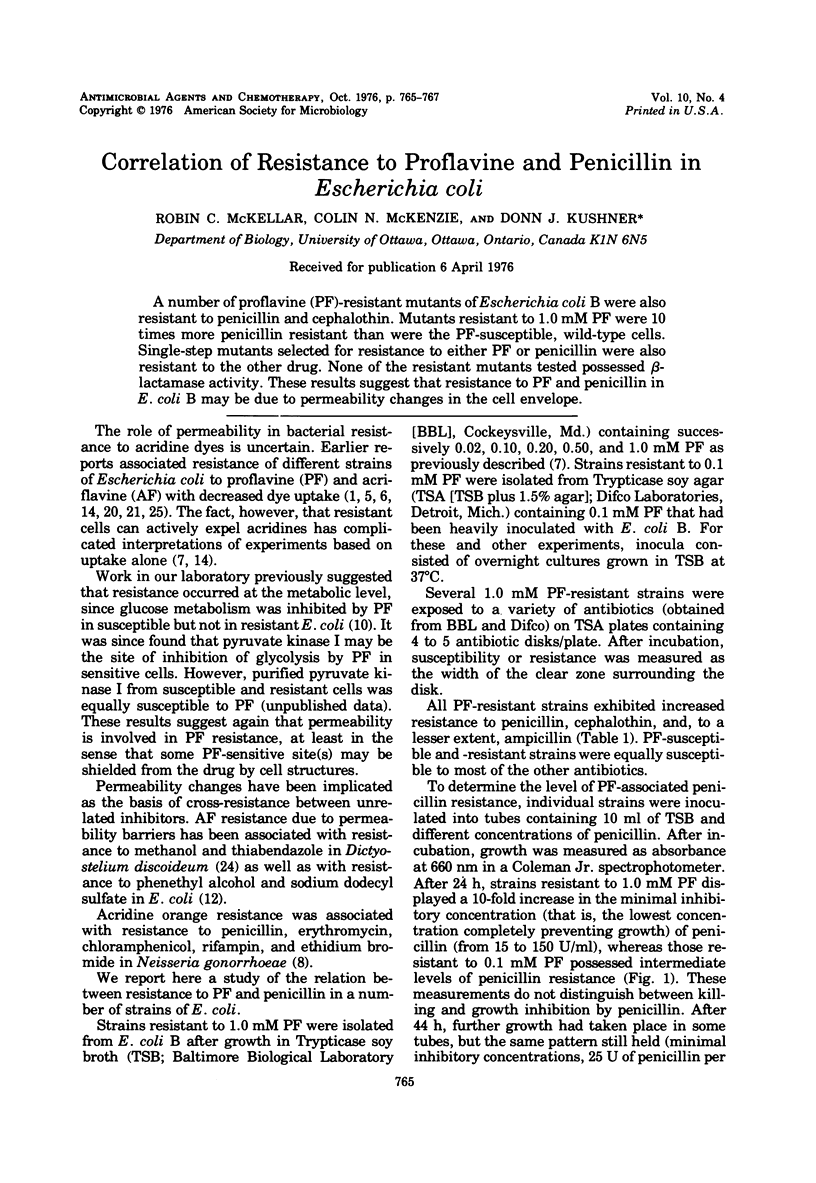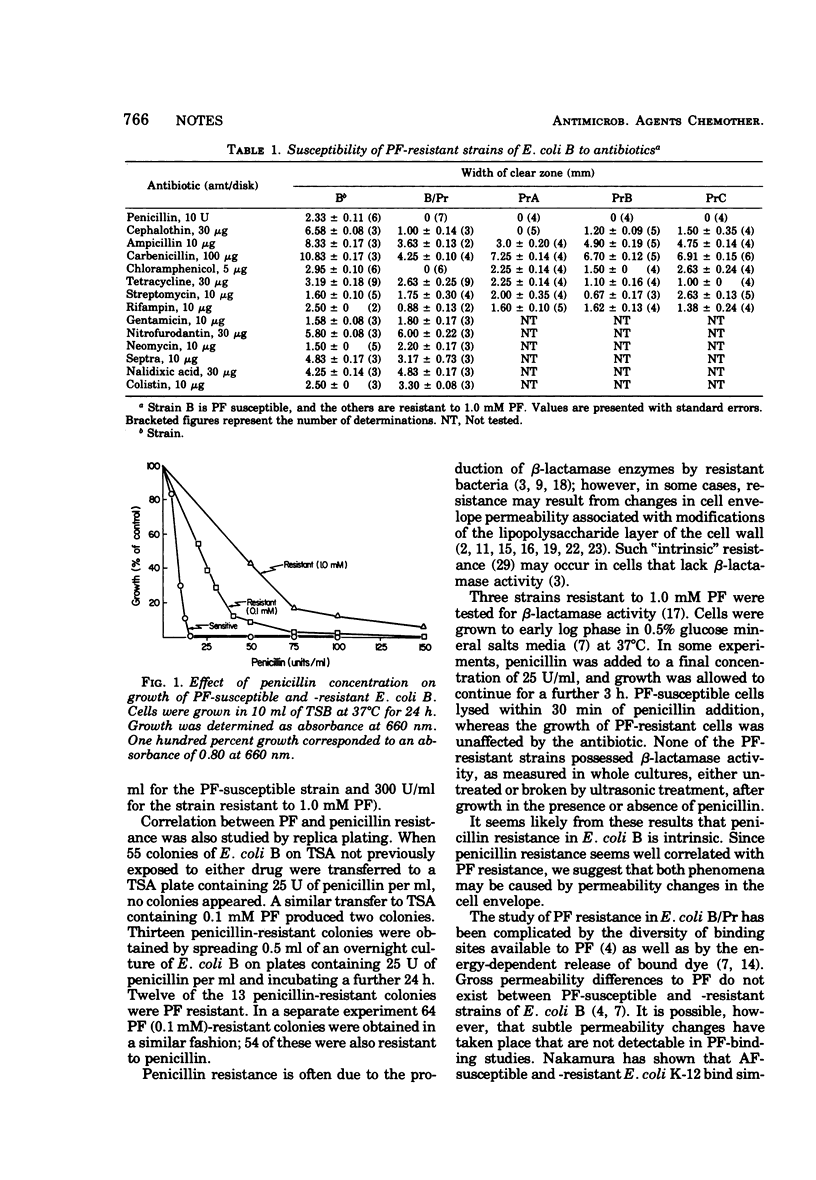Abstract
A number of proflavine (PF)-resistant mutants of Escherichia coli B were also resistant to penicillin and cephalothin. Mutants resistant to 1.0 mM PF were 10 times more penicillin resistant than were the PF-susceptible, wild-type cells. Single-step mutants selected for resistance to either PF or penicillin were also resistant to the other drug. None of the resistant mutants tested possessed β-lactamase activity. These results suggest that resistance to PF and penicillin in E. coli B may be due to permeability changes in the cell envelope.
Full text
PDF


Selected References
These references are in PubMed. This may not be the complete list of references from this article.
- Barabas G., Mehta B. M., Kushner D. J. Proflavine binding and release by sensitive and resistant Bacillus subtilis. Can J Microbiol. 1970 Oct;16(10):973–981. doi: 10.1139/m70-166. [DOI] [PubMed] [Google Scholar]
- Barrett E., Asscher A. W. Action of ethylenediaminetetra-acetic acid (EDTA) on carbenicillin-resistant strains of Pseudomonas aeruginosa. J Med Microbiol. 1972 Aug;5(3):355–359. doi: 10.1099/00222615-5-3-355. [DOI] [PubMed] [Google Scholar]
- Gravelle M. J., Mehta B. M., Kushner D. J. The elusive permeability barriers and binding sites for proflavine in Escherichia coli. Antimicrob Agents Chemother. 1972 Jun;1(6):470–475. doi: 10.1128/aac.1.6.470. [DOI] [PMC free article] [PubMed] [Google Scholar]
- Hessler A. Y. Acridine resistance in bacteriophage T2H as a function of dye penetration measured by mutagenesis and photoinactivation. Genetics. 1965 Oct;52(4):711–722. doi: 10.1093/genetics/52.4.711. [DOI] [PMC free article] [PubMed] [Google Scholar]
- Kohno T., Roth J. R. Proflavin mutagenesis of bacteria. J Mol Biol. 1974 Oct 15;89(1):17–32. doi: 10.1016/0022-2836(74)90160-0. [DOI] [PubMed] [Google Scholar]
- Kushner D. J., Khan S. R. Proflavine Uptake and Release in Sensitive and Resistant Escherichia coli. J Bacteriol. 1968 Oct;96(4):1103–1114. doi: 10.1128/jb.96.4.1103-1114.1968. [DOI] [PMC free article] [PubMed] [Google Scholar]
- Maness M. J., Sparling P. F. Multiple antibiotic resistance due to a single mutation in Neisseria gonorrhoeae. J Infect Dis. 1973 Sep;128(3):321–330. doi: 10.1093/infdis/128.3.321. [DOI] [PubMed] [Google Scholar]
- Mehta B. M., Gravelle M. J., Kushner D. J. Effects of energy metabolism on the release of bound proflavine from sensitive and resistant Escherichia coli. Antimicrob Agents Chemother. 1973 Sep;4(3):332–336. doi: 10.1128/aac.4.3.332. [DOI] [PMC free article] [PubMed] [Google Scholar]
- Monner D. A., Jonsson S., Boman H. G. Ampicillin-resistant mutants of Escherichia coli K-12 with lipopolysaccharide alterations affecting mating ability and susceptibility to sex-specific bacteriophages. J Bacteriol. 1971 Aug;107(2):420–432. doi: 10.1128/jb.107.2.420-432.1971. [DOI] [PMC free article] [PubMed] [Google Scholar]
- NOVICK R. P. Micro-iodometric assay for penicillinase. Biochem J. 1962 May;83:236–240. doi: 10.1042/bj0830236. [DOI] [PMC free article] [PubMed] [Google Scholar]
- Nakamura H. Genetic determination of resistance to acriflavine, phenethyl alcohol, and sodium dodecyl sulfate in Escherichia coli. J Bacteriol. 1968 Oct;96(4):987–996. doi: 10.1128/jb.96.4.987-996.1968. [DOI] [PMC free article] [PubMed] [Google Scholar]
- Nakamura H. Plasmid-instability in acrA mutants of Escherichia coli K12. J Gen Microbiol. 1974 Sep;84(1):85–93. doi: 10.1099/00221287-84-1-85. [DOI] [PubMed] [Google Scholar]
- Nakamura H., Suganuma A. Membrane mutation associated with sensitivity to acriflavine in Escherichia coli. J Bacteriol. 1972 Apr;110(1):329–335. doi: 10.1128/jb.110.1.329-335.1972. [DOI] [PMC free article] [PubMed] [Google Scholar]
- Nelson B. W., Roantree R. J. Analyses of lipopolysaccharides extracted from penicillin-resistant, serum-sensitive salmonella mutants. J Gen Microbiol. 1967 Aug;48(2):179–188. doi: 10.1099/00221287-48-2-179. [DOI] [PubMed] [Google Scholar]
- Nordström K., Burman L. G., Eriksson-Grennberg K. G. Resistance of Escherichia coli to penicillins. 8. Physiology of a class II ampicillin-resistant mutant. J Bacteriol. 1970 Mar;101(3):659–668. doi: 10.1128/jb.101.3.659-668.1970. [DOI] [PMC free article] [PubMed] [Google Scholar]
- Richmond M. H., Jack G. W., Sykes R. B. Mechanisms of drug resistance. The beta-lactamases of gram-negative bacteria including pseudomonads. Ann N Y Acad Sci. 1971 Jun 11;182:243–257. doi: 10.1111/j.1749-6632.1971.tb30661.x. [DOI] [PubMed] [Google Scholar]
- Richmond M. H., Sykes R. B. The beta-lactamases of gram-negative bacteria and their possible physiological role. Adv Microb Physiol. 1973;9:31–88. doi: 10.1016/s0065-2911(08)60376-8. [DOI] [PubMed] [Google Scholar]
- SILVER S. ACRIFLAVINE RESISTANCE: A BACTERIOPHAGE MUTATION AFFECTING THE UPTAKE OF DYE BY THE INFECTED BACTERIAL CELLS. Proc Natl Acad Sci U S A. 1965 Jan;53:24–30. doi: 10.1073/pnas.53.1.24. [DOI] [PMC free article] [PubMed] [Google Scholar]
- Silver S., Levine E., Spielman P. M. Acridine binding by Escherichia coli: pH dependency and strain differences. J Bacteriol. 1968 Feb;95(2):333–339. doi: 10.1128/jb.95.2.333-339.1968. [DOI] [PMC free article] [PubMed] [Google Scholar]
- Suginaka H., Ichikawa A., Kotani S. Penicillin-resistant mechanisms in Pseudomonas aeruginosa: effects of penicillin G and carbenicillin on transpeptidase and C -alanine carboxypeptidase activities. Antimicrob Agents Chemother. 1974 Dec;6(6):672–675. doi: 10.1128/aac.6.6.672. [DOI] [PMC free article] [PubMed] [Google Scholar]
- Weiser R., Asscher A. W., Wimpenny J. In vitro reversal of antibiotic resistance by ethylenediamine tetraacetic acid. Nature. 1968 Sep 28;219(5161):1365–1366. doi: 10.1038/2191365a0. [DOI] [PubMed] [Google Scholar]
- Williams K. L., Kessin R. H., Newell P. C. Parasexual genetics in Dictyostelium discoideum: mitotic analysis of acriflavin resistance and growth in axenic medium. J Gen Microbiol. 1974 Sep;84(1):59–69. doi: 10.1099/00221287-84-1-59. [DOI] [PubMed] [Google Scholar]
- Woods D. R., Schauder V. R., Waddington P. B. Acriflavine uptake and resistance in Serratia marcescens cells and spheroplasts. J Bacteriol. 1973 Apr;114(1):59–64. doi: 10.1128/jb.114.1.59-64.1973. [DOI] [PMC free article] [PubMed] [Google Scholar]


